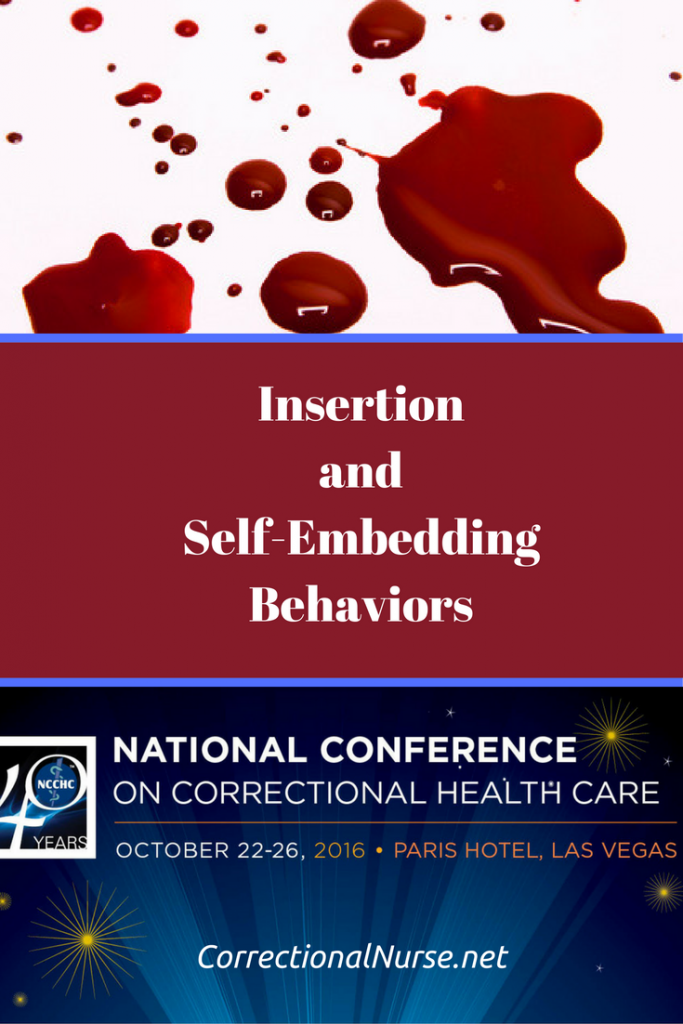Mitzi Peterson, MSW, LICSW, CCHP, and Michael Beauchemin, MA, work for Massachusetts Department of Correction. This post is based on their session “Management of Insertion and Self-Embedding Behaviors” taking place at the 2016 National Conference on Correctional Health Care in Las Vegas, October 22-26, 2016. Learn more about the conference and register HERE.
 A 32 year old white male is brought to the medical unit with a pen embedded in his right forearm. During the initial assessment he tells the nurse he inserted it himself and is hoping to be transferred to the protective mental health unit. The arm is swollen and may be infected. The nurse practitioner on shift works with the nurse to remove the pen, clean and stitch the wound, and start antibiotic treatment. A mental health evaluation is scheduled.
A 32 year old white male is brought to the medical unit with a pen embedded in his right forearm. During the initial assessment he tells the nurse he inserted it himself and is hoping to be transferred to the protective mental health unit. The arm is swollen and may be infected. The nurse practitioner on shift works with the nurse to remove the pen, clean and stitch the wound, and start antibiotic treatment. A mental health evaluation is scheduled.
The Massachusetts Department of Corrections (MADOC) has seen a significant increase in insertion and self-embedding behaviors among the behaviorally challenging and the mentally ill. In 2015, 11 inmates used this behavior in 25 incidents. In addition, 49 incidents of insertion or self-embedding occurred in the state hospital run by MADOC. Some inmates appear to use these behaviors in an attempt to obtain pain medications while others appear to be less goal-directed and are seeking psychological relief.
When patients insert or self-embed, they are not attempting suicide but are trying to injure themselves. Insertion involves the placement of foreign bodies into the urethra, anus, vagina, or other body orifice. Similarly, self-embedding involves placing foreign objects into the soft tissues of the body. Disturbed individuals use these behaviors in response to internal and external stressors. The cause is unclear but is often linked to such conditions as PTSD, Borderline Personality Disorder and Anti-Social Personality Disorder. In the example above, the inmate had a strong motivation to be transferred to a different location in the prison. The stressors of his current location moved him to take an extreme action.
Management of Insertion and Embedding Behaviors
Management of inserters/self-embedders is challenging and requires an individualized approach. Here are key concepts in treatment plan development.
- Determining the person’s goal in using the behavior is critical in order to best devise a response and recovery plan.
- Behavior management plans with incentives that reduce self-injury behaviors and use practical devices to prevent impulsive behaviors have been effective.
- Communication between all providers is imperative in order to provide a consistent response to the behavior and to avoid potential rewarding of dangerous self-injury.
- When possible, referral to a Residential Treatment Unit is made in order to place the inmate in a therapeutic milieu for ongoing treatment and monitoring.
Challenges of Management
Here are some of the challenges encountered by the MADOC when working to manage the increasing incidents of inserting and self-embedding behaviors.
- Identification of the behavior is the first challenge as it requires self-disclosure. This often happens when medical involvement is necessary, as in the example above.
- In addition, it is very challenging to restrict access to items that can be inserted or imbedded. Inmates and patients are very skilled at using items which correctional professionals have yet to consider.
- Once the self-injury has occurred, it can be a challenge to understand the cause that resulted in the behavior.
- Medical care for the removal of or management of an inserted or embedded item requires significant monitoring in an environment of potential infection.
The Future of Self-Injury Treatment
Correctional systems must work together to collect data about what is working, what is not working and what our next steps should be when faced with these complicated forms of self-injurious behaviors. Intent and motivation are key variables which we should all be assessing in order to build a knowledge base for future intervention building.
Have you cared for a self-injuring patient? Share your experience in the comments section of this post.
This post is part of a series discussing topics addressed during sessions of the 2016 National Conference on Correctional Health Care. All posts in this series can be found HERE.
Cheralee Worrall says
We had a patient diagnosed with Munchhausen Syndrome. He chronically placed items in an old abdominal wound that would not heal due to him picking at/placing items in the wound. He inserted a pencil while in our custody resulting in emergency surgery. A few days later – he broke off metal vent pieces and inserted them in his wound. Another trip to the ER. He was a very difficult keeper for the couple weeks we had him in custody.